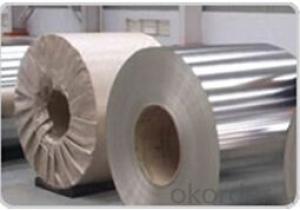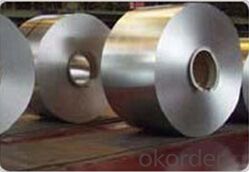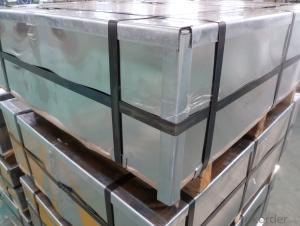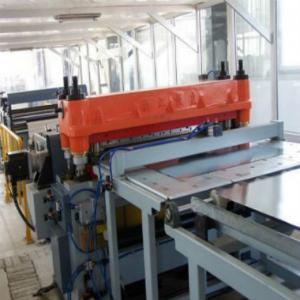Prime Quality TFS for Caps and Body Cans Use
- Loading Port:
- Shanghai
- Payment Terms:
- TT OR LC
- Min Order Qty:
- 25 m.t.
- Supply Capability:
- 1000 m.t./month
OKorder Service Pledge
OKorder Financial Service
You Might Also Like
Specification
Prime Quality TFS for Caps and Body Use
1.Structure of Description
Prime Quality TFS for Caps and Body Use is one of the metal packing materials, which is widely used for making painting cans ,chemical package cans , electrical cable ,battery and metal printing etc.
2. Main Features
Steady and high quality
Fast shipment
Good experience for export work
For the surface, Plate uniform in thickness,uniform and smooth tin coating, without flaws,rusts,scratch,wave,nick of tin coating etc.
Price competitive
3. Images

4. Specification
Standard : GB2520-2000 ,JIS G3303
Steel type : SPCC
Coating : 2.8/2.8
Surface: Bright, Stone ,
Thickness:0.31
Width :600MM~1000MM
Temper : T1~T5
Package: tinplate wrapped completely with an inner cover of plastic or waterproof papers with vorners protected with metal angels.
5.FAQ
A. What is the package of TFS? (Referred as below)
For sheets, thin plastic film + rust-proof paper + metallic cover + metallic angles+ steel band strips + fumigated wooden pallet.
For coil, thin plastic film + rust proof paper + metallic cover + steel band strips + fumigated wooden pallet
B. The surface of tinplate could you supply?
Stone finish, Bright finish, Matte finish, Silver finish
- Q: How does tinplate packaging contribute to product differentiation?
- Tinplate packaging contributes to product differentiation by providing a unique and attractive look that distinguishes a product from its competitors. The use of tinplate allows for creative and eye-catching designs, which can effectively communicate the brand's identity and create a memorable impression on consumers. Additionally, tinplate packaging offers durability and protection, ensuring that the product remains in good condition throughout its shelf life. This enhances the overall perceived value of the product and sets it apart from alternatives, thus contributing to product differentiation.
- Q: How is tinplate coated with protective lacquer?
- Tinplate is coated with protective lacquer by first cleaning and pre-treating the surface to remove any contaminants. Then, a thin layer of lacquer is applied onto the tinplate using various methods such as roller-coating or spray-coating. The lacquer acts as a barrier, protecting the tinplate from corrosion, oxidation, and other external factors that may affect its quality and durability.
- Q: How is the thickness of tinplate measured?
- The thickness of tinplate is typically measured using a specialized instrument called a micrometer, which accurately measures the distance between the surfaces of the tin coating.
- Q: How does tinplate packaging contribute to product protection against light?
- Tinplate packaging contributes to product protection against light by providing a durable and opaque barrier. Its metallic properties prevent light from penetrating through the packaging, thus minimizing exposure to UV rays and other forms of light that can degrade the quality and shelf life of sensitive products.
- Q: How does tinplate contribute to the reduction of carbon emissions?
- Tinplate contributes to the reduction of carbon emissions through its sustainable production process and recyclability. Compared to other packaging materials, tinplate has a low carbon footprint as it requires less energy and releases fewer greenhouse gases during manufacturing. Additionally, tinplate is a highly recyclable material, allowing for the efficient reuse of resources and reducing the need for new production. By promoting the use of tinplate, we can minimize carbon emissions and work towards a more environmentally friendly packaging solution.
- Q: What are the main trends in tinplate packaging?
- Some of the main trends in tinplate packaging include the increasing demand for sustainable and eco-friendly packaging solutions, the rise of convenient and innovative packaging designs, and the incorporation of advanced technologies for improved product protection and preservation. Additionally, there is a growing preference for personalized and customized tinplate packaging to enhance brand identity and consumer engagement.
- Q: Why tin printing after a layer of light oil
- Bright oil is common in epoxy resin, alkyd resin, acrylic resin, acrylic amino, etc., the composition is different, the performance is also different, and the use is not the same. Usually according to the process whether there is a deep stamping deformation, welding local high temperature heating and the need for high pressure cooking and so on, choose different types of varnish.In order to increase production efficiency and save energy, in general, the last printing process is combined with the glazing process.In addition to the roller coating can be used, but also can be printed light ink method, both gloss is not much difference, but the processing performance is better than roller coating.
- Q: Can tinplate packaging be used for gardening products?
- Yes, tinplate packaging can be used for gardening products. Tinplate is a durable material that provides protection against moisture and can withstand outdoor conditions. It is commonly used for packaging fertilizers, pesticides, seeds, and other gardening supplies. Additionally, tinplate is recyclable, making it an eco-friendly choice for garden product packaging.
- Q: How long does tinplate take to corrode?
- The time it takes for tinplate to corrode can vary depending on various factors such as the environment, exposure to moisture, and the presence of corrosive substances. However, tinplate is generally known for its excellent corrosion resistance, and under normal conditions, it can take several years or even decades before significant corrosion occurs.
- Q: How is tinplate coated with food-grade materials?
- Tinplate is coated with food-grade materials through a process called electrolytic tinning. In this process, a thin layer of tin is electroplated onto the surface of the tinplate, creating a protective barrier between the metal and the food. This coating ensures that the tinplate is safe for food contact and prevents any undesirable reactions between the metal and the food.
Send your message to us
Prime Quality TFS for Caps and Body Cans Use
- Loading Port:
- Shanghai
- Payment Terms:
- TT OR LC
- Min Order Qty:
- 25 m.t.
- Supply Capability:
- 1000 m.t./month
OKorder Service Pledge
OKorder Financial Service
Similar products
Hot products
Hot Searches
Related keywords






























